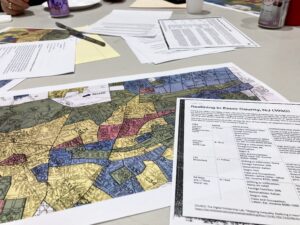#008: Red Roads and Fishing Villages
July 17, 2025
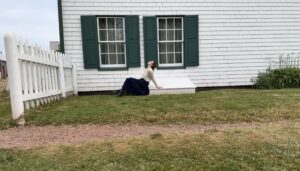
Erin at Green Gables Heritage Place, PEI
My family recently returned from a very meaningful trip—my long-awaited pilgrimage to Prince Edward Island, paired with following in my grandparents’ footsteps to visit Nova Scotia.
Alongside working on the Crane House & Historic YWCA performance project, I have spent the last year also diving into the life and world of Lucy Maud Montgomery, the famed Canadian writer of the “Anne of Green Gables” character. I’ve reread her novels and short stories, rewatched film adaptations, read biographies and scholarly articles, and immersed myself in various historical and fan podcasts.
Visiting PEI was nothing short of magical for me, with the pages of description and love for the land coming to life—the red roads, salty breeze, sparkling waters, red cliffs, bends in the road, rolling hills of farmland, and effects of changing light throughout the days. Likely because of my close connection to the books and research, I could only describe my overall time there as having a sense of belonging.

Cavendish, PEI
Visiting the historical sites related to Maud’s life, the Green Gables Heritage Place captured it all—a truly beautiful and remarkable tribute. I reached out to them prior to our trip and received permission to create a dance film on-site. While I could have used 10 cameras and 10 more days, it was a special time connecting to the site and author in this way—the inspiration for the Anne books.

“Invisible Harvest” at Peggy’s Cove, NS
The second part of our trip took us from PEI to Nova Scotia, with the main goal of visiting Peggy’s Cove. This is where the cover of my grandfather Thomas John Carlisle’s poetry book “Invisible Harvest” was photographed by my grandmother in the 70s. The book—and the poetry and images inside—has become part of the Carlisle family story. The area hasn’t changed much over the past few decades, and I could understand why the Carlisle family has such a connection to the region.
Much like the Crane House & Historic YWCA project, this trip reinforced my deep interest in how personal and collective histories live in specific places—and how movement and dance can be a way to physically and emotionally engage with those layered stories.
-Erin Carlisle Norton
#007: The hills are alive with the sound of music
June 20, 2025

One fun and unexpected aspect of working on the Crane House & Historic YWCA dance project has been the deep dive into finding music. Since each room in the house represents a specific era – the Parlor (1796–1840), Dining Room (1840–1900), Boarders’ Dining Room (1920–1940), and Club Room (1940–1965) – I decided that the music for each room’s dance should reflect the time periods as well. This translates also into being mindful of how music was experienced during those times – using live music (avoiding today’s Bluetooth alternatives), a radio, and a record player. As part of this process, I’ve been looking for music that supports the eras and stories of the rooms without overpowering or dictating the choreography.
Musically, I’ve been drawn in recent projects to rhythmically driven digital sound scores (think Frank Bretschneider and Michael Wall), but this project led me to seek out female composers from each era. Unsurprisingly, the results were limited, since women have faced barriers to compose music and/or were often not recognized for their work in music composition. Still, Spotify has been a treasure trove – a far cry from the days I browsed CDs in the university Music & Dance Library! I created playlists for each room and have tested them in rehearsals—it’s been an interesting adventure for me to both use music I would typically never use, and to find music that supports the stories, choreography, and spirit of each room. Two standouts so far: “A-Tisket, A-Tasket” by Ella Fitzgerald (so fun!), and Amy Beach’s “2 Mother Songs” (the emotions!) – and the dancers are enjoying the music range too. Yet another way this project has been interesting, inspiring, and has kept me growing as an artist.
-Songwriters: Ella Fitzgerald / Van Alexander
-Erin Carlisle Norton
#006: Mid-project Checkpoint
May 27, 2025

Artistic Director, Erin Carlisle Norton 5.16.25 Community Showing
It’s been a very full and creatively rich past month. We’ve been deep in rehearsals, finalized costumes, and had an incredible photo shoot with Julie Lemberger that beautifully captured the spirit of this work. We also prepared for a community work-in-progress showing – an evening that highlighted not only the Crane House & Historic YWCA project, but much of where I’ve been putting my time the last six months.
 The showing featured a new dance film we recorded last fall at Broadway Presbyterian Church, which I’ve been editing over the last few weeks (featuring stained glass, a labyrinth, and a bungee cord). It also included a performance by participants in The Moving Architects Performance Project program that was held this spring, along with the earliest public glimpse of our Crane House and Historic YWCA performance project.
The showing featured a new dance film we recorded last fall at Broadway Presbyterian Church, which I’ve been editing over the last few weeks (featuring stained glass, a labyrinth, and a bungee cord). It also included a performance by participants in The Moving Architects Performance Project program that was held this spring, along with the earliest public glimpse of our Crane House and Historic YWCA performance project.
The evening was everything I could have hoped for. We had a warm, engaged audience of friends, family, and community members. The dancers gave compelling, deeply connected performances, and we were supported with the overall self-production of the night by our TMA board and administrator. The event also generated meaningful conversations – about all the work, the ideas behind it, and the process of making something site-inspired and site-specific.
 We shared this work in a Montclair venue new to us, Union Congregational Church —a spacious community setting with high ceilings and a welcoming atmosphere. The size of the room allowed the work to breathe, and at the same time, it felt grounded and personal.
We shared this work in a Montclair venue new to us, Union Congregational Church —a spacious community setting with high ceilings and a welcoming atmosphere. The size of the room allowed the work to breathe, and at the same time, it felt grounded and personal.
Audience feedback for the Crane project was thoughtful and supportive – many any said they were very excited to experience the finished piece in person – how close the dancers would be, how the costumes, sound, and historical setting could transport them to the time period of each room. It’s exactly the kind of resonance we hoped for.
This showing marked a valuable checkpoint – it gave us a strong sense of where the project stands and what’s taking shape. For me personally, it also reaffirmed how ambitious this work is – but also how deeply rewarding it has become. We are building something meaningful on many levels.
-Erin Carlisle Norton
#005: Costumes
April 27, 2025
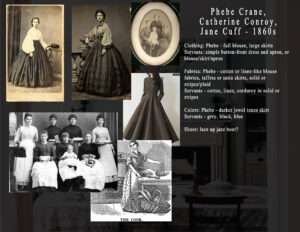 Costumes have been a focus leading up to our upcoming photo shoot, and working with Janessa Urwin has been key. After sharing the project details and overall vision with her, Janessa created mood boards for each room, giving us clear
Costumes have been a focus leading up to our upcoming photo shoot, and working with Janessa Urwin has been key. After sharing the project details and overall vision with her, Janessa created mood boards for each room, giving us clear 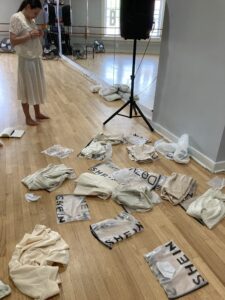 direction on the styles, textures, and silhouettes tied to each room’s time period, pulling from archival images of the house and general history. Rehearsing in the intimate rooms made it clear that the spaces already offer so much to see—the architecture, set pieces, and small details—and that overly elaborate costumes could be too much to take in alongside the dancing. Dance often works within very tight budgets, and this project is no different, with Janessa helping to source and guide costume pieces rather than creating them from scratch. It’s amazing to see how much sourcing costumes has changed over the past twenty years when we relied mostly on our own closets, thrift store finds, and the occasional department store. For this project, we decided on a palette of all cream costumes while keeping the focus on the dancers, dancing, and the relationship to the spaces around them, paying particular attention to skirt lengths, textures, and blouse and shirt cuts to reflect each room’s time period.
direction on the styles, textures, and silhouettes tied to each room’s time period, pulling from archival images of the house and general history. Rehearsing in the intimate rooms made it clear that the spaces already offer so much to see—the architecture, set pieces, and small details—and that overly elaborate costumes could be too much to take in alongside the dancing. Dance often works within very tight budgets, and this project is no different, with Janessa helping to source and guide costume pieces rather than creating them from scratch. It’s amazing to see how much sourcing costumes has changed over the past twenty years when we relied mostly on our own closets, thrift store finds, and the occasional department store. For this project, we decided on a palette of all cream costumes while keeping the focus on the dancers, dancing, and the relationship to the spaces around them, paying particular attention to skirt lengths, textures, and blouse and shirt cuts to reflect each room’s time period.
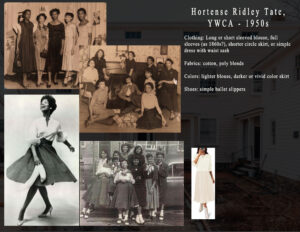 Here are a couple of the original mood boards along with a photo from this week’s costume try-ons during rehearsal. We are looking forward to an upcoming photoshoot with Julie Lemberger at Crane House & Historic YWCA.
Here are a couple of the original mood boards along with a photo from this week’s costume try-ons during rehearsal. We are looking forward to an upcoming photoshoot with Julie Lemberger at Crane House & Historic YWCA.
-Erin Carlisle Norton
#004: Onsite
April 7, 2025
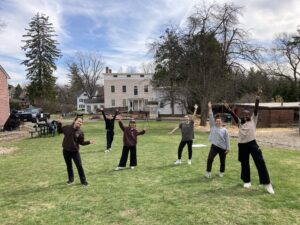
L-R; Karma, Mariah, Nicole, Kelly, Emily, Cece
During March, we spent 2 days onsite at the Crane House & Historic YWCA, inside the building and the outside grounds. Each of the 6 company dancers in the project was able to experience the site – and below are some early reflections on this time together and the project.
This weekend at Crane House with The Moving Architects was a deeply enriching experience that fostered a sense of closeness among all artists. As we explored each room, I became more attuned to the unique atmosphere and mood of the space, which enhanced my connection to the project. Overall, the collaboration and shared creativity left me feeling inspired and energized for future endeavors. – Karma Chuki

Emily in the Boarder’s Dining Room
As part of our research, we watched a documentary about the women of the YWCA. What stayed with me was the incredible strength and support that existed in their community. We initially started rehearsing in small groups to focus on different rooms of the house. But after coming together with all the dancers, who I also see as powerful, supportive women, I feel connected to the spirit of the women who were in the house at that time. – Kelly Guerrero
Creating a dance show in a historic home is pretty unique as performance venues go. The Crane House has a lot of character of its own, and it’s full of so many individual stories that inspiration is endless when you’re there making movement. It’s an honor to be entrusted to bring to life such a stalwart of the community. I’m excited to continue exploring how the real space informs what we do and how we relate to each other, there’s no studio that is a suitable substitute for being in the actual rooms where history was made. I just wish those walls could talk. – Mariah Anton-Arters
Having rehearsal at the Crane House was such a powerful experience. Being able to move through the historic rooms, surrounded by artifacts and stories of the women who once lived there, made the space feel alive in a new way. Dancing in the backyard, with its vast and open landscape, was equally inspiring—it gave me a sense of freedom and connection to the past. The house holds so much history, particularly about women, and embodying movement in that space felt deeply empowering. – Cece Mitchell
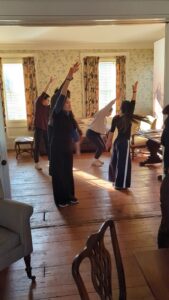
Club Room
I am very grateful for this residency; it gave me the opportunity to look through each room in person and then explore movement in the Club Room. Workshopping within the actual space was incredibly informative, especially with all of us there. It offered time to figure out what worked, what didn’t, and where things needed to be modified —whether it was spacing, expansiveness of a gesture, our facings, etc. To me, this experience also made this project feel more tangible in a way. We are embodying specific or overarching stories that encompass hundreds of years’ worth of history that tie back to this house. By getting time to be in this structure, I got to see where these women spent their time every day, and as we continue to generate movement and choreography in the studio, I find that I can reflect on my experience in the Club Room and what insights I gathered from visiting the other rooms. – Nicole Arakaki
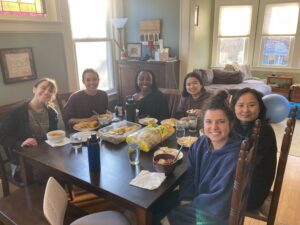
Company Dinner
Being a part of this project has been a powerful and unique experience filled with learning, unlearning, and openness. The Crane House holds the stories of those that came before us, and their voices can be felt within the home. It has been an honor to hold space in the Crane House, and I look forward to continuing to grow and create with the other movement artists, museum caretakers, and the community. – Emily Cicio
#003: Women’s Voices
February 25, 2025
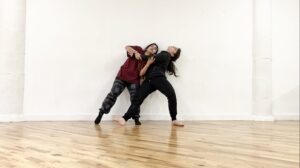
Dancers: Nicole Arakaki and Mariah Anton-Arters
I am enjoying the rehearsal process! It feels creatively fresh, new, and full of possibility on every level – a process that embraces story and history, with conversations and questions that arise as we reflect on the lives of women in various roles and situations from the 1790s to the 1960s. Their lives were shaped by constraints, and we are tapping into that both physically by embodying their stories through the choreography and literally as we create movement and relationships made for each room in the parameters of the house. Rooms with walls, fireplaces, furniture, etc. aren’t typical performance spaces, but they are full of possibilities to embrace the intimacy of gesture, nuance, and dynamics, alongside tension and ease between the dancers or in solos. The idea of the modern dance stare has never been more cringeworthy as we imagine the nearby audience members – instead, I see, every glance, shift, and hesitation holding meaning, pulling us into the work, and drawing us further into the women’s lived experiences.
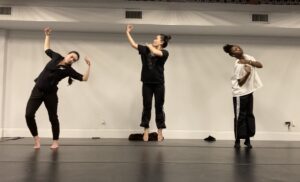
Dancers: Kelly Guererro, Karma Chuki, Cecilia Mitchell
Collaborating and working with familiar and new dancers has been an energizing blend of newness, ease, unease, expectation, and discovery. Rehearsals unfold like a conversation – sometimes fluid, sometimes fragmented – as we navigate ourselves within this project and in relationship to the stories we are learning and to each other. So many questions in the best of ways.
-Erin Carlisle Norton
#002: Redlining
January 30, 2025
Redlining can be defined as a discriminatory practice that consists of the systematic denial of services such as mortgages, insurance loans, and other financial services to residents of certain areas, based on their race or ethnicity. Redlining disregards individual’s qualifications and creditworthiness to refuse such services, solely based on the residency of those individuals in minority neighborhoods; which were also quite often deemed “hazardous” or “dangerous”.
I recently attended a community event that featured a viewing of Segregated by Design and a discussion on the legacy of redlining, including its specific history in Montclair, NJ. Just weeks earlier, I had examined a redlining map of Montclair at the Montclair History Center, making the discussion feel especially timely. As I traced the areas where I live, work, and frequent, I could still picture the lasting effects of those outlined boundaries—visible in the types of housing, the distribution of wealth, and the neighborhoods themselves, nearly a century later. It would be fascinating to overlay a current Montclair zoning map and census data onto the 1939 redlining map to see, in real data, what has changed and what has remained the same.
At the same time, as I read through the history of the Crane family, I am beginning to understand their status, access, and education in relation to the region—New Jersey, Montclair, and nearby New York City—and how this intersected with their ownership of enslaved people and servants. Beyond the historical facts, I want to grasp the real impact and struggles of those who lived and worked in the house—how their lives were shaped by these systems of power and oppression. And then, in a striking turn, how the house later transformed into a home and center for African American girls and women as a YWCA.
The redlining discussion reinforces the importance of understanding the past—not only to learn from it, but to acknowledge it and build a more just future with that knowledge.
-Erin Carlisle Norton
#001: The Beginnings
January 4, 2025
“It takes a thousand voices to tell a single story. Whose voices do you hear in this house?”
– printed in large letters on the wall inside Crane House & Historic YWCA.
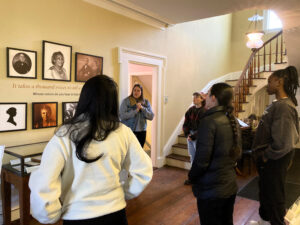
Entryway of Crane House & Historic YWCA
We have begun! Yesterday The Moving Architects had a tour of Montclair History Center’s Crane House & Historic YWCA – the official start to our site-specific dance project set for September 2025. After a fall of initial planning, grant writing, bringing together project dancers, and early studio solo work, it felt good to be in the space together.

Crane Family Tree Close-up
Our tour was led by the knowledgeable and enthusiastic Angelica Dibbs, Executive Director of Montclair History Center. She guided us in learning and understanding more about the people who lived and breathed in the rooms from 1796 to the present and with this, the fascinating, layered, and surprising history of the structure itself. She was a wealth of information, and we look forward to digging through the archives and watching documentaries to learn more.

Cece, Emily, Kelly, and Karma at the back entrance after tour
I find sacredness in embodying and spending time in historical sites and spaces, taking in and imagining the lived histories within the architecture or landscape. I felt this recently when filming a dance project at Broadway Presbyterian Church in NYC and creating on the shores of Lummi Island in Washington State, and I felt it again yesterday. We had time to settle in. We turned on the record player in the Club Room (1940-1965) and heard a scratchy 1950s Elvis Presley – leading us to imagine the social gatherings when the building was a YWCA. We looked closely at the family tree hand drawing in the Dining Room (1840-1900), which led us to visualize the lives and deaths of a wealthy family lineage. We walked the creaky, sturdy wood stairs, imagining the immigrants and enslaved people who worked in the house over the decades. We read and examined artifacts in each room that represented a different period, inspected details up close,studied room compositions from afar, and simply sat and took in the spaces.
The beginning is an exciting place to be.
-Erin Carlisle Norton



